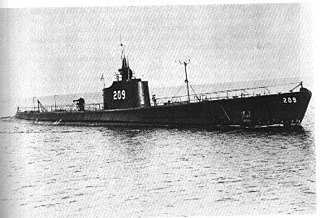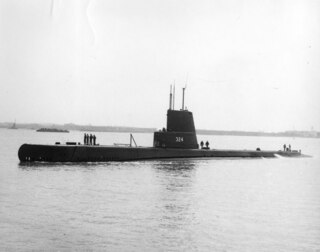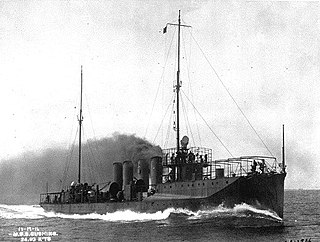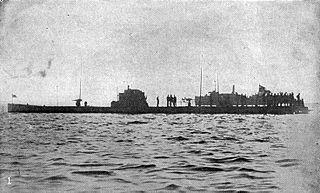
USS Holland (SS-1) was the United States Navy's first modern commissioned submarine, although not the first military submarine of the United States, which was the 1775 submersible Turtle. The boat was originally laid down as Holland VI at the Crescent Shipyard of Elizabeth, New Jersey for John Philip Holland's Holland Torpedo Boat Company, and launched on 17 May 1897. She was acquired by the USN on 11 April 1900 and commissioned on 12 October 1900, Lieutenant H. H. Caldwell commanding.

USS Bowfin (SS/AGSS-287), is a Balao-class submarine of the United States Navy named for the bowfin fish. Since 1981, she has been open to public tours at the USS Bowfin Submarine Museum & Park in Pearl Harbor, Hawaii, next to the USS Arizona Memorial Visitor Center.

USS G-1 (SS-19½) was the lead ship of her class of submarine of the United States Navy. While the four G-boats were nominally all of a class, they differed enough in significant details that they are sometimes considered to be four unique boats, each in a class by herself.

USS Darter (SS-227), a Gato-class submarine, was the first ship of the United States Navy to be named for the darter.

USS Grayling (SS-209) was the tenth Tambor-class submarine to be commissioned in the United States Navy in the years leading up to the country's December 1941 entry into World War II. She was the fourth ship of the United States Navy to be named for the grayling. Her wartime service was in the Pacific Ocean. She completed seven war patrols in the following 20 months, and is credited with the sinking of over 20,000 tons of Japanese merchant shipping and warships. Grayling received six battle stars for her World War II service. She was declared lost with all hands in September 1943. Of the twelve Tambor-class submarines, only five survived the war.

USS Jacob Jones was a Tucker-class destroyer built for the United States Navy prior to the American entry into World War I. The ship was the first U.S. Navy vessel named in honor of Jacob Jones.

USS Mingo (SS-261) — a Gato-class submarine — was the first ship of the United States Navy to be named for the mingo snapper.

USS Blenny (SS/AGSS-324), a Balao-class submarine in commission from 1944 to 1969, was a ship of the United States Navy named for the blenny, a fish found along the rocky shores of the Atlantic Ocean. During World War II, Blenny conducted four war patrols in the Java Sea and South China Sea between 10 November 1944 and 14 August 1945. She sank eight Japanese vessels totaling 18,262 tons. In addition, she is credited with destroying more than 62 miscellaneous Japanese small craft by gunfire.

The first USS Fanning (DD-37) was a modified Paulding-class destroyer in the United States Navy during World War I and later in the United States Coast Guard, designated as CG-11. Her namesake was Nathaniel Fanning.

USS N-5 (SS-57) was a N-class coastal defense submarine of the United States Navy. Her keel was laid down on 10 April 1915 by Lake Torpedo Boat Company in Bridgeport, Connecticut. The N-boats built by Lake had slightly different specifications from the ones built by Seattle Construction and Drydock and are sometimes considered a separate class.

USS D-3 (SS-19) was a D-class submarine built for the United States Navy in the first decade of the 20th century. It was the first submarine to make an over ocean voyage under its own power.

USS Balch was an Aylwin-class destroyer built for the United States Navy prior to the American entry into World War I. The ship was the first U.S. Navy vessel named in honor of George Beale Balch, a US Navy officer who served in the Mexican–American War and the American Civil War, and as Superintendent of the United States Naval Academy.

USS Winslow was an O'Brien-class destroyer built for the United States Navy prior to the American entry into World War I. The ship was the second US Navy vessel named in honor of John Ancrum Winslow, a US Navy officer notable for sinking the Confederate commerce raider CSS Alabama during the American Civil War.

USS Cushing was an O'Brien-class destroyer built for the United States Navy prior to the American entry into World War I. The ship was the second U.S. Navy vessel named in honor of William B. Cushing, a U.S. Navy officer best known for sinking the Confederate ironclad warship CSS Albemarle during the American Civil War.

USS Ericsson was an O'Brien-class destroyer built for the United States Navy prior to the American entry into World War I. The ship was the second U.S. Navy vessel named in honor of John Ericsson, the Swedish-born builder of the ironclad warship USS Monitor during the American Civil War.

USS Hunt (DD-194) was a Clemson-class destroyer in the United States Navy following World War I. She also served in the United States Coast Guard, as USCGD Hunt (CG-18). She was later transferred to the Royal Navy as HMS Broadway (H90).

SM U-53 was one of the six Type U 51 U-boats of the Imperial German Navy during the First World War.

United States Navy operations during World War I began on April 6, 1917, after the formal declaration of war on the German Empire. The United States Navy focused on countering enemy U-boats in the Atlantic Ocean and the Mediterranean Sea while convoying men and supplies to France and Italy. Because of United States's late entry into the war, her capital ships never engaged the German fleet and few decisive submarine actions occurred.
USS Charles Whittemore (ID-3232) was a four masted lumber schooner used as a decoy ship against German U-boats during World War I.



















